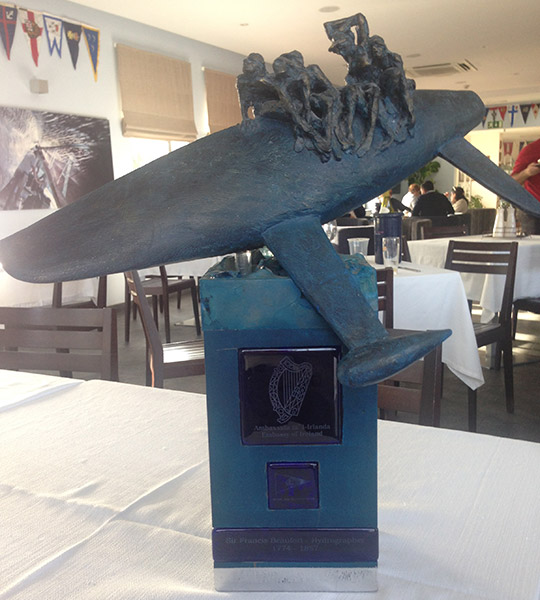St. Patrick's Regatta Trophy, Sir Beaufort Cup, RMYC
Ambassador Mac Coscair presented the Sir Beaufort Cup to the winners of the Royal Malta Yacht Club's (RYMC) St Patrick's Weekend Regatta on Sunday 20th March.
Presentation of Saint Patrick's Regatta Trophy, RMYC, 20 March 2016
Address by Ambassador Mac Coscair.
Ladies and Gentlemen.
I was asked to explain the significance of the name of this trophy, Sir Francis Beaufort, for Ireland and sea-faring. But before I do I want to mention some of the options we considered.
The first was Saint Brendan the Navigator.
Brendan, who lived in the 7th century, was one of our earliest and most famous sea-farers.
The stories of his Voyages were first written down around 900AD and there are over 100 manuscripts of the story across Europe, as well as many additional translations.
What is important is not his Voyages in themselves nor his discovery of America 800 years before Colombus but that at the time, sea-faring stories, or immrama as they were called, were hugely popular in Ireland showing that the Irish love of telling, and listening to tales of the sea is not a new phenomenon.
However, as the Royal Malta Yacht Club is no place for a Saint we spared Brendan's blushes.
Then we thought about the Sea Queen of Connaught, Grace O'Malley or Gráinne Mhaol as she is known to the Irish. In the 16th century her fleet commanded the seas off the west and south coasts of Ireland.
She became fabulously wealthy by charging a toll on ships travelling through the waters where she controlled.
Naturally, the Crown found this difficult to accept but as Grace never accepted English Rule she thought it was just grand.
She is best known for travelling to London in her flagship and negotiating directly with Queen Elizabeth, as an equal, to secure the release of her two sons and her half-brother who had been captured by the English.
However, a woman of such capability, action and independent spirit might put some of the male members of the Royal Malta Yacht Club to shame, so I discounted Grace to spare their blushes.
The the name of the Irishman Sir Francis Beaufort was suggested,.
Francis will be primarily known for his development of the Beaufort Scale. He was born in Navan, County Meath, in Ireland not far from the family-seat of the Duke of Wellington in the 1770's.
He went to sea at 13 and rose to the rank of rear-Admiral in the Navy.
He was a self-taught scientist and continued his education throughout his life and freely associated with the likes of John Herschel and Charles Babbage.
Having being shipwrecked at the age of 15 because of incorrect charts his interests turned to hydrography and observational accuracy.
He was in Malta during 1810-1812 from where he conducted surveys, geographical and hydrographical, of the easter Mediterranean.
In the 1820's he was named British Admiralty Hydrographer of the Navy. He converted what had been a minor chart repository into the finest surveying and charting institution in the world. Some of the excellent charts the Office produced are still in use today.
Beaufort also gained the support of his fellow Irishman the Prime Minister, the Duke of Wellington, in expanding record-keeping at 200 British Coast guard stations.
An interesting aside is that he trained Robert Fitzroy, the Master of the Survey Ship, The Beagle. When Fitzroy asked Beaufort to recommend a scientist for his five year exhibition, Beaufort suggested a chap called Charles Darwin and the rest, as they say, is history.
So in conclusion, you can see that Sir Francis Beaufort's contribution to seafaring safety, his Irish origins and his connection with Malta means that this trophy is aptly named.


